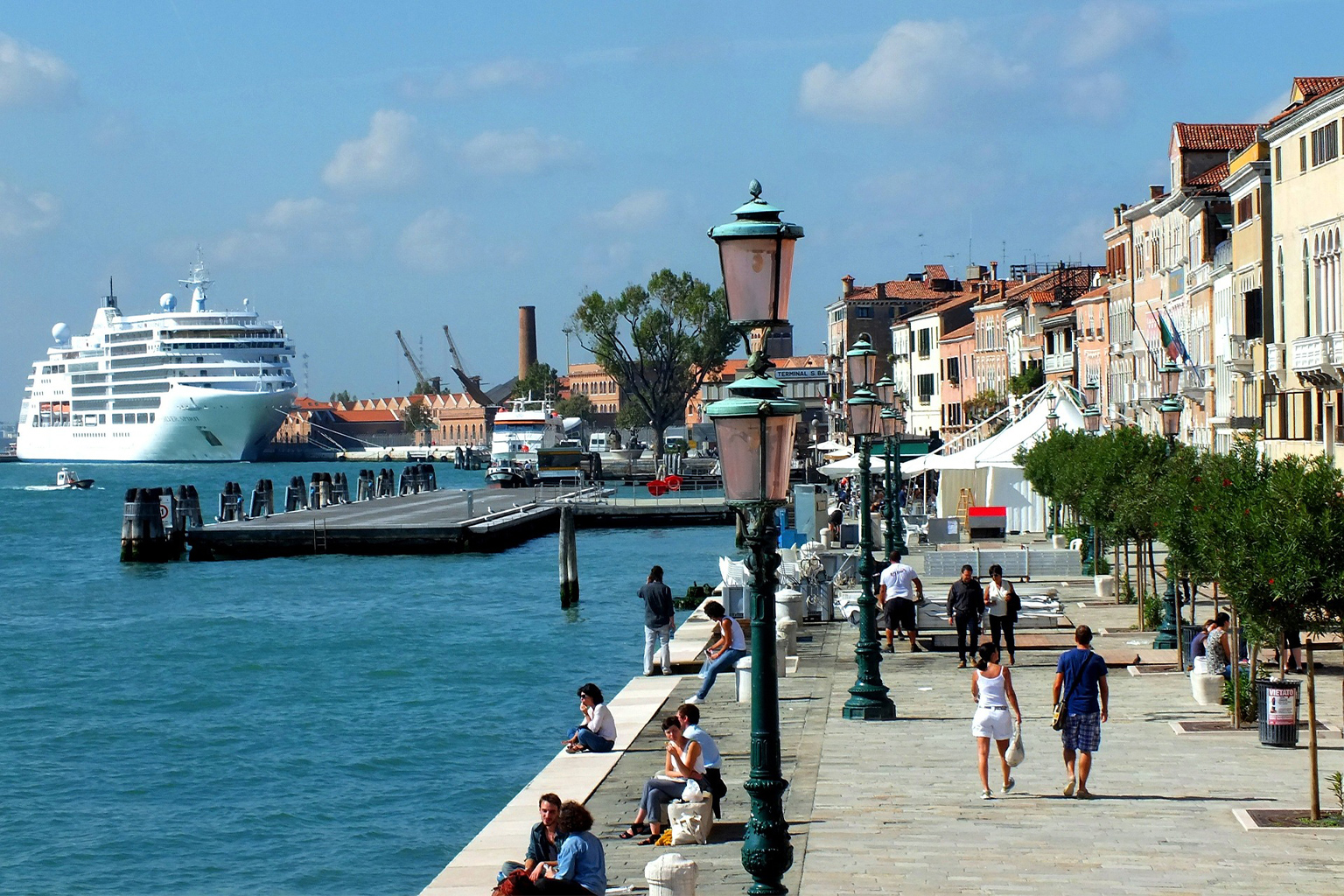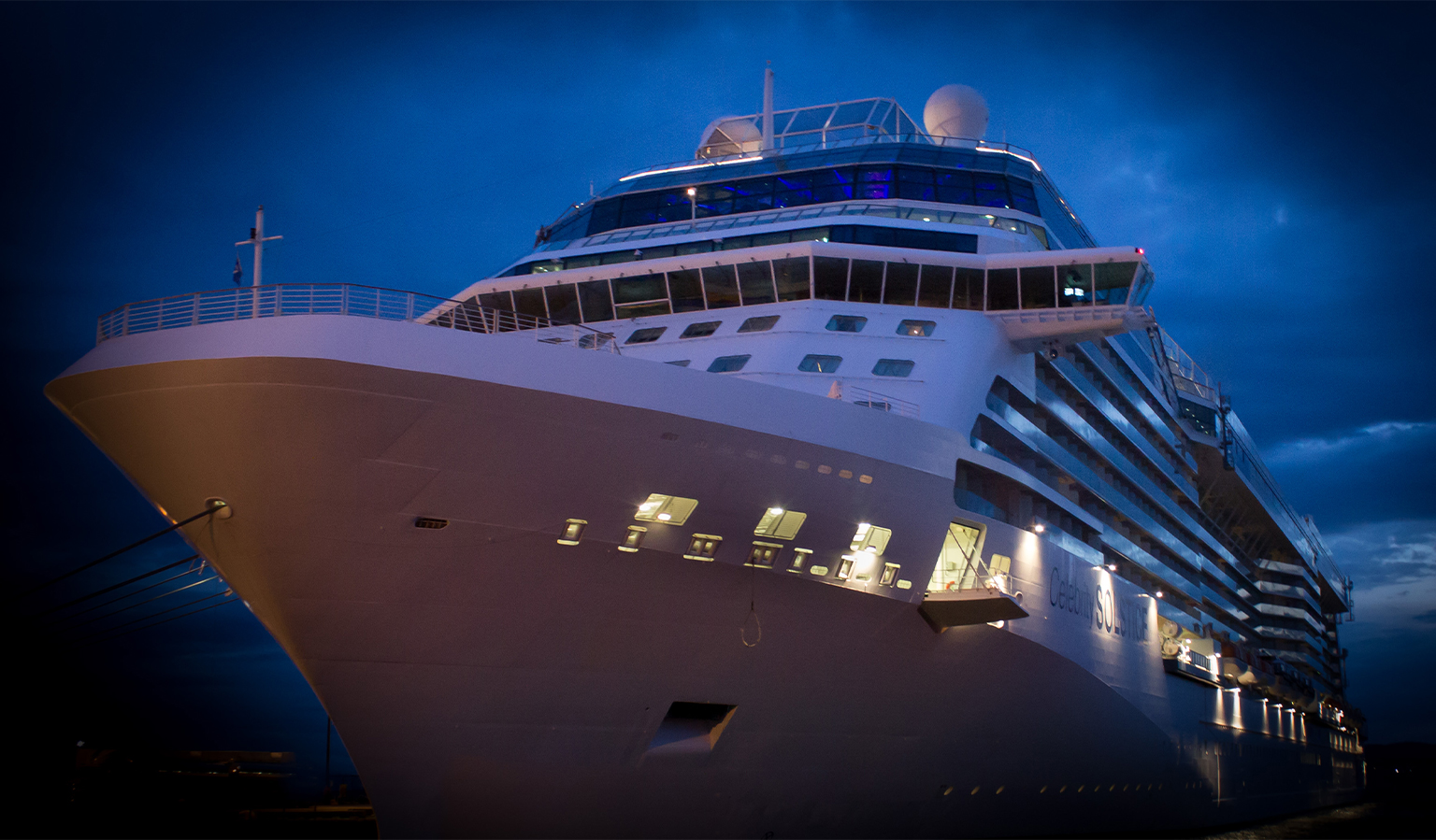Cleaning up cruise ships’ environmental wake
Oct 4, 2023 / Mongabay / Story by Rebecca Kessler
- For years, campaigners have highlighted the unsustainable practices of the cruise ship industry, including the massive vessels’ dumping of sewage and wastewater, and their emissions of air pollutants and greenhouse gases.
- The cruise industry says it’s working hard to limit its environmental footprint, with the adoption of advanced wastewater treatment systems, cleaner fuels, and other sustainability measures.
- Jurisdictions around the globe have begun tightening rules to limit the effects of visiting ships.
- Critics and advocates remain unconvinced, arguing that much more needs to be done at a far faster pace to tackle cruisers’ global impact on the ocean and air.
In July, Amsterdam became the latest in a series of cities to regulate against huge cruise ships in an attempt to tackle pollution and the burden of overtourism. The Dutch capital joins other cities, such as Venice in Italy, Monterey Bay in California, and Bar Harbor in Maine, in seeking to limit the impact of cruises.
Around the same time, Transport Canada, a national regulator, took its own steps to tackle cruise waste: It upgraded measures that prohibit ship wastewater disposal in the sea from voluntary to mandatory. For years, Canada’s national waters were likened to a “toilet bowl” due to lax regulations enabling cruise ships passing through the country’s waters to dump sewage at will, according to campaigners.
“Making the voluntary program into a mandatory one allows enforcement to come in and brings the possibility of fines,” Anna Barford, shipping campaigner for U.S.- and Canada-based NGO Stand.Earth, told Mongabay. She said cruisers dumped as much as 32 billion gallons, or about 121 million cubic meters, of waste in Canadian waters in 2019. “This is absolutely a good and right step.”
Meanwhile, the cruise industry says it’s working hard to limit its environmental footprint across the globe, including greenhouse gas emissions and harm to oceans and air. Critics and advocates argue that much more needs to be done at a far faster pace to tackle cruisers’ global impact.
U.S.-based NGO Friends of the Earth releases an annual scorecard that grades cruise ship companies on their environmental impacts. The most recent, from 2022, looked at 18 major cruise lines, giving the top overall grade, a C+, to a single company. Three others received C-range grades, seven got D-range grades, and seven got the lowest grade: an F. Despite the poor overall scores, some companies are improving when it comes to issues such as air and water pollution, said Marcie Keever, the group’s oceans and vessels program director. But the industry writ large remains mired in harmful activities, underpinned by a general lack of transparency by many players, she said.
“For all the parameters that we look at with our report card on the cruise industry — for all of the big cruise ship companies almost across the board — none of them are doing what they should be doing when it comes to environmental protection and their footprint,” Keever told Mongabay.

Cleaning up waterborne waste
For some time, campaigners have highlighted the dumping of sewage and wastewater as the face of an unsustainable cruise industry.
To tackle the issue, cruise ship owners are installing advanced wastewater treatment systems. Such treatment systems can completely cleanse a ship’s wastewater — from sources such as sinks, showers and toilets — to the point that some of it can be recycled for other on-ship uses, according to Sascha Gill, vice president of sustainability at Cruise Lines International Association (CLIA). The trade group represents the owners of 292 cruise ships, roughly 95% of the global fleet, according to Gill. CLIA member companies served roughly 30 million passengers per year pre-COVID-19.
Of the 264 ships in CLIA members’ fleets whose owners responded to a survey by the association, 202, or 76.5%, are equipped with advanced wastewater treatment systems (28 did not respond). Gill told Mongabay that CLIA members will achieve 100% coverage as older vessels are retired and new ones come with readymade systems installed. He didn’t give a time frame for this transition.
However, critics contend a lack of oversight and transparency persists in the industry when it comes to the treatment facilities’ effectiveness. “We don’t have the details, and we don’t have, which is the most important, independent third-party audits or third-party assessment of technology,” Hrvoje Carić, a researcher at Croatia’s Institute for Tourism, told Mongabay.
Current international regulations, under the International Convention for the Prevention of Pollution from Ships (MARPOL) Annex IV, require ships to have treatment facilities installed, prohibit the discharge of treated sewage within 3 nautical miles (5.6 kilometers) of shore, and prohibit the discharge of untreated sewage within 12 nmi (22 km) of shore. Advocates say illegal dumping continues to occur.
Experts are also concerned that while these advanced systems may offer a high degree of waste treatment, they don’t fix all problems. Maartje Folbert, a Ph.D. researcher in environmental sciences at the Open University of the Netherlands, said that similar to onshore treatment methods, shipboard systems capture contaminants, such as microplastics, but concentrate them in sewage sludge.
“Even though treatment will be quite effective at removing microplastics and other contaminants from wastewater, a large proportion would still end up in the ocean if sewage sludge is discharged overboard,” whether legally or illegally, she said.
In Folbert’s view, simply treating waste isn’t sufficient and companies must take a “broad perspective” on the variety and sources of pollutants to ensure adequate wastewater management. This means considering the fate of substances like microplastics, caffeine and pharmaceuticals that can escape treatment. Potential solutions include transparent regulation of sewage-sludge handling, addressing pollutants at the source by phasing out single-use plastics and products that may contain microplastics, such as cosmetics and cleaning products, applying laundry filters, and improving both the use and availability of port reception facilities to deal with sewage sludge, she said.


Shifting to the air
Air pollution is another significant impact of cruise ships. A report released earlier this year by the Brussels-based NGO Transport & Environment detailed that Europe’s fleet of 218 cruise ships emitted as much sulfur oxide in 2022 as a billion cars. The cruise industry disputes the figure.
To comply with regulations put in place in 2020 under MARPOL that mandate emissions reductions, the industry is building new cruise ships that use alternative fuels, mainly liquefied natural gas (LNG). This offers the potential to reduce pollution and lower CO2 emissions. However, via a process known as “methane slip,” this fuel can also exacerbate emissions of this shorter-lived, but more potent greenhouse gas, according to research.
Other efforts to reduce air pollution, such exhaust-gas cleaning systems, also known as scrubbers, can contribute to water contamination. These systems wash seawater through ship exhaust. Open-loop systems send the wash water directly into the sea, and it can be hot, highly acidic and contain a host of pollutants, including particulate matter, polycyclic aromatic hydrocarbons, and heavy metals. Closed-loop systems recirculate and continuously treat freshwater, collecting the resulting waste on board for later disposal on shore. Hybrid systems can toggle between open and closed loops.
CLIA states that around 150 ships in its members’ fleets are equipped with scrubbers, of which around one-third are open-loop systems. Their use will be phased out with the switch to new fuels such as LNG, Gill said.
The scrubber problem isn’t confined to cruise ships. A survey by the International Council on Clean Transportation estimates that, worldwide, the shipping industry dumps at least 10 billion metric tons of scrubber wash water into the sea annually; cruise ships account for around 15% of that figure. This can exacerbate ocean acidification, already ramping up with climate change, and directly impact ocean life, including fragile coral reefs, the council’s website states.
According to Stand.Earth’s Barford, the vast majority — around 90% — of wastewater pollution in Canada’s waters is scrubber water. Canada’s newly mandatory regulations don’t touch scrubbers, she said, meaning they don’t address a large portion of pollution. “What we’re asking for is a ban on the use of scrubbers,” she said.
At the global level, regulators should remove an exemption that allows ships to use scrubbers instead of burning low-sulfur fuels, she added. “We know that sulfur in the air is a problem for humans and for wildlife. In the water, it’s also going to cause problems,” she said.

Fast enough?
To reduce cruise ships’ environmental footprint, advocates argue that the industry and regulators must do much more, particularly when it comes to the largest ships.
CLIA’s Gill, however, said international MARPOL regulations are already strict and clear. In addition, future-ready fleets are being fitted with various technologies to tidy themselves up: advanced wastewater treatment systems, onshore electricity connectivity to reduce air pollution in ports, and clean fuels will all become standard, he added.
But advocates, such as Stand.Earth and Friends of the Earth, state that these steps must be taken immediately.
Carić said there’s a further need for “a very transparent and hard look” at the entirety of cruise ships’ environmental impacts, particularly for the largest vessels, via life-cycle assessments. “Governments should involve science in this process,” he said, “not only crews, corporations, and interested stakeholders.”
Banner image: A study published last year in the journal Marine Pollution Bulletin states the cruise industry “remains a major source of air, water (fresh and marine) and land pollution affecting fragile habitats, areas and species, and a potential source of physical and mental human health risks.” Experts say the largest vessels generally have the most significant environmental impacts. Image by Adam Gonzales via Unsplash (Public domain).
Citations:
Ytreberg, E., Hansson, K., Hermansson, A. L., Parsmo, R., Lagerström, M., Jalkanen, J., & Hassellöv, I. (2022). Metal and PAH loads from ships and boats, relative other sources, in the Baltic Sea. Marine Pollution Bulletin, 182, 113904. doi:10.1016/j.marpolbul.2022.113904
Folbert, M. E., Corbin, C., & Löhr, A. J. (2022). Sources and leakages of microplastics in cruise ship wastewater. Frontiers in Marine Science, 9. doi:10.3389/fmars.2022.900047
Lloret, J., Carreño, A., Carić, H., San, J., & Fleming, L. E. (2021). Environmental and human health impacts of cruise tourism: A review. Marine Pollution Bulletin, 173, 112979. doi:10.1016/j.marpolbul.2021.112979
Kotrikla, A. M., Zavantias, A., & Kaloupi, M. (2021). Waste generation and management onboard a cruise ship: A case study. Ocean & Coastal Management, 212, 105850. doi:10.1016/j.ocecoaman.2021.105850
Endres, S., Maes, F., Hopkins, F., Houghton, K., Mårtensson, E. M., Oeffner, J., … Turner, D. (2018). A new perspective at the ship-air-sea-Interface: The environmental impacts of exhaust gas scrubber discharge. Frontiers in Marine Science, 5. doi:10.3389/fmars.2018.00139
FEEDBACK: Use this form to send a message to the editor of this post. If you want to post a public comment, you can do that at the bottom of the page.